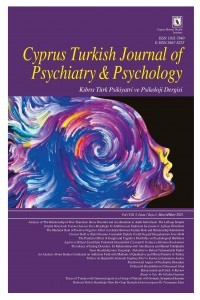Use of Vanoxerine Consta In Cocaine Addiction: A Case Report
Use of Vanoxerine Consta In Cocaine Addiction: A Case Report
addiction, cocaine, vanoxerine,
___
- Andersen, P. H. (1989). The dopamine uptake inhibitor GBR 12909: selectivity and molecular mechanism of action.European Journal of Pharmacology, 166, 493-509.
- Andersen, P. H. (1989). The dopamine uptake inhibitor GBR 12909: selectivity and molecular mechanism of action. European journal of pharmacology, 166(3), 493-504
- Castells, X., Casas, M., Pérez‐Mañá, C., Roncero, C., Vidal, X., & Capella, D. (2010). Efficacy of psychostimulant drugs for cocaine dependence. Cochrane Database of Systematic Reviews, (2).
- Fensbo, C., Montgomery, S. A., Andersen, J., Hallstrom, C., Schonbeck, G., Zwaan, M., M0oler Nielsen, E. M., Olafsson, K., Ingwersen, S. H. & Skrumsager, B. K. (1990). GBR 12909: A dose response relationship of the selective dopamine uptake inhibitor in major depression. XVIIth Congress of Collegium Internationale Neuro-Psychopharmacologicum, Kyoto. Abstract 0-11-9-3.
- Glowa, J.R., Wojnicki, F.H.E., Matecka, D., Rice, K.C., Rothman, R.B. (1995b) Effects of dopamine reuptake inhibitors on food and cocaine maintained responding II: comparison with other drugs and repeated administration .Experimental and Clinical Psychopharmacology 3:232–239.
- Hanzlick, R., Gowitt, G.T., (1991). Cocaine metabolite detection in homicide victims. The Journal of the American Medical Association 265:760–761.
- Holman, R.B. (1994). Biological effects of central nervous system stimulants. Addiction, 89(11), 1435-1441.
- Hyman, S.E. (1996) Addiction to cocaine and amphetamine. Neuron, 16(5), 901-904.
- Kalivas, P.W.; Duffy, P. (1990) Effect of acute and daily cocaine treatment on extracellular dopamine in the nucleus accumbens. Synapse, 5(1), 48-58.
- Koob, G.F. Nestler, E.J. (1997). The neurobiology of drug addiction. The Journal of Neuropsychiatry and Clinical Neurosciences, 9(3), 482-497.
- Luoh, H.F. Kuo, T.B. Chan, S.H. Pan, W.H. (1994). Power spectral analysis of electroencephalographic desynchronization induced by cocaine in rats: correlation with microdialysis evaluation of dopaminergic neurotransmission at the medial prefrontal cortex. Synapse, 16(1), 29-35.
- Matsumoto, N., Khrestian, C. M., Ryu, K., Lacerda, A. E., Brown, A. M., & Waldo, A. L. (2010). Vanoxerine, a new drug for terminating atrial fibrillation and flutter. Journal of cardiovascular electrophysiology, 21(3), 311-319.
- Rothman, R.B., Mele, A., Reid, A.A., Akunne, H.C., Greig, N., Thurkauf, A. (1991). GBR 12909 antagonizes the ability of cocaine to elevate extracellular levels of dopamine. Pharmacology Biochemistry and Behavior, 40:387–397.
- Volkow, N.D., Wang, G.J., Fowler, J.S., Logan, J., Gatley, S.J., Wong, C. (1999). Reinforcing effects of psychostimulants in humans areassociated with increases in brain dopamine and occupancyof D2 receptors.Journal of Pharmacology and Experimental Therapeutics 291:409–415.
- Volkow, N. D., Wang, G. J., Fowler, J. S., Logan, J., Franceschi, D., Maynard, L., ... & Swanson, J. M. (2002). Relationship between blockade of dopamine transporters by oral methylphenidate and the increases in extracellular dopamine: therapeutic implications. Synapse, 43(3), 181-187.
- ISSN: 1302-7840
- Yayın Aralığı: Yılda 4 Sayı
- Başlangıç: 2000
- Yayıncı: Kıbrıs Ruh Sağlığı Enstitüsü
Bağımlılıkta Aşerme ile İlgili Yapılan Lisansüstü Çalışmalar Üzerine Bir İnceleme
Metamfetamin Bağımlısı Bir Olgunun Yedam Modeli İle Tedavisi ve Takibi
Aylin IŞIK, Gülsüm Melike ŞİMŞEK
Hilmi Ertuğ BAKİ, Mevhibe İrem YILDIZ, Berna Diclenur ULUĞ
Büşra KAHRAMAN, Aslıhan Özlem POLAT IŞIK
Yedam Madde Bağımlılığı Stigmatizasyon Ölçeği
Mehmet DİNÇ, G. Melike ŞİMŞEK, Aylin IŞIK, Kültegin ÖGEL
Aşırı Dijital Oyun Oynama Davranışında Anne Tutumu Ve Benlik Kontrolünün Etkisi
N. Kübra ORMAN, Osman Tolga ARICAK
Alkol-Madde Bağımlılarında D Tipi Kişilik Özellikleri ve Aleksitimi
Alkol-Madde Bağımlılarının Kan Parametrelerinin Kıyaslanması
